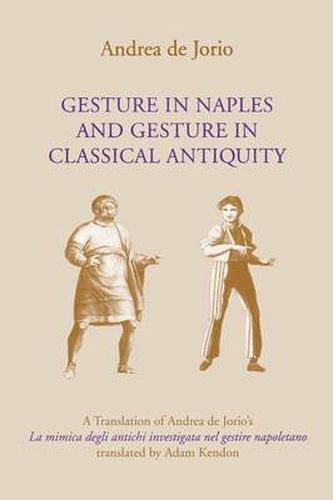Readings Newsletter
Become a Readings Member to make your shopping experience even easier.
Sign in or sign up for free!
You’re not far away from qualifying for FREE standard shipping within Australia
You’ve qualified for FREE standard shipping within Australia
The cart is loading…






Andrea de Jorio’s La mimica degli antichi investigata nel gestire napoletano (‘Gestural Expression of the Ancients in the light of Neapolitan gesturing’), was first published in Naples in 1832. It soon became famous for its descriptions and depictions of Neapolitan gestures, but it is only with the recent expansion of scholarly interest in gesture that its true importance has come to be recognised. It is the first book ever written which presents what is, in effect, an ethnographic study of gesture. Treating gesture as a culturally established communicative code, analogous to language, the book sets out to describe, with reference to an explicitly defined cultural group, the gestural expressions of ordinary people as these are used in everyday life. It also deals with numerous issues important for any semiotics of gesture, such as the question of the relationship between physical form and meaning, the problem of how to present a description of the gestural repertoire of a community in a consistent manner, the importance of context for the interpretation of gesture, how gestures may be combined, how they develop as metaphorical expressions, among many others. Andrea de Jorio (1769-1851) was a cleric and a Canon of the Cathedral of Naples, but he was also an archaeologist and a curator at the Royal Borbonic Museum (today the National Archaeological Museum) in that city. He was an expert on Greek vases and intimately involved in all aspects of archaeology then developing in relation to the excavations at Herculaneum, Pompeii, Pozzuoli, Cuma and other sites within the district of Naples. He believed that the ordinary people of Naples had preserved in their culture the traditions of the ancient Greek founders of the city. For this reason he supposed that an understanding of contemporary gestural expression would be useful in interpreting the gestures and bodily postures depicted in the frescoes, mosaics, sculptures, and painted vases of Greco-Roman antiquity that had come to light from the excavations near Naples and elsewhere. Thus he was led to describe the gesturing of contemporary Neapolitans as fully as possible. Adam Kendon has added annotations to his translation so that the book is fully accessible to the modern reader. He has also written a long essay which provides an account of de Jorio’s life and work and shows how his book is related to the cultural and intellectual climate of the Naples of his day. It gives a detailed analysis of de Jorio’s views on gesture, and it also discusses gesture use in relation to the culture and ecology of daily life in Naples at that time. There are three detailed bibliographical appendices.
$9.00 standard shipping within Australia
FREE standard shipping within Australia for orders over $100.00
Express & International shipping calculated at checkout
Andrea de Jorio’s La mimica degli antichi investigata nel gestire napoletano (‘Gestural Expression of the Ancients in the light of Neapolitan gesturing’), was first published in Naples in 1832. It soon became famous for its descriptions and depictions of Neapolitan gestures, but it is only with the recent expansion of scholarly interest in gesture that its true importance has come to be recognised. It is the first book ever written which presents what is, in effect, an ethnographic study of gesture. Treating gesture as a culturally established communicative code, analogous to language, the book sets out to describe, with reference to an explicitly defined cultural group, the gestural expressions of ordinary people as these are used in everyday life. It also deals with numerous issues important for any semiotics of gesture, such as the question of the relationship between physical form and meaning, the problem of how to present a description of the gestural repertoire of a community in a consistent manner, the importance of context for the interpretation of gesture, how gestures may be combined, how they develop as metaphorical expressions, among many others. Andrea de Jorio (1769-1851) was a cleric and a Canon of the Cathedral of Naples, but he was also an archaeologist and a curator at the Royal Borbonic Museum (today the National Archaeological Museum) in that city. He was an expert on Greek vases and intimately involved in all aspects of archaeology then developing in relation to the excavations at Herculaneum, Pompeii, Pozzuoli, Cuma and other sites within the district of Naples. He believed that the ordinary people of Naples had preserved in their culture the traditions of the ancient Greek founders of the city. For this reason he supposed that an understanding of contemporary gestural expression would be useful in interpreting the gestures and bodily postures depicted in the frescoes, mosaics, sculptures, and painted vases of Greco-Roman antiquity that had come to light from the excavations near Naples and elsewhere. Thus he was led to describe the gesturing of contemporary Neapolitans as fully as possible. Adam Kendon has added annotations to his translation so that the book is fully accessible to the modern reader. He has also written a long essay which provides an account of de Jorio’s life and work and shows how his book is related to the cultural and intellectual climate of the Naples of his day. It gives a detailed analysis of de Jorio’s views on gesture, and it also discusses gesture use in relation to the culture and ecology of daily life in Naples at that time. There are three detailed bibliographical appendices.